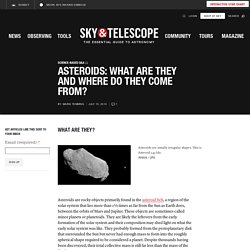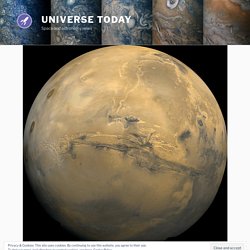

Humans Will Never Colonise Mars. The suggestion that humans will soon set up bustling, long-lasting colonies on Mars is something many of us take for granted.

What this lofty vision fails to appreciate, however, are the monumental — if not intractable — challenges awaiting colonists who want to permanently live on Mars. Unless we radically adapt our brains and bodies to the harsh Martian environment, the Red Planet will forever remain off limits to humans. Asteroids: What Are They and Where Do They Come From? - Sky & Telescope - Sky & Telescope. What Are They?

Asteroids are rocky objects primarily found in the asteroid belt, a region of the solar system that lies more than 2 ½ times as far from the Sun as Earth does, between the orbits of Mars and Jupiter. These objects are sometimes called minor planets or planetoids. They are likely the leftovers from the early formation of the solar system and their composition may shed light on what the early solar system was like.
They probably formed from the protoplanetary disk that surrounded the Sun but never had enough mass to form into the roughly spherical shape required to be considered a planet. How do asteroids orbit? Almost all of the asteroids in our solar system are orbiting in a broad band 19,400,000 miles wide between Jupiter and Mars.

The asteroids are orbiting the Sun, each one traveling around the Sun fast enough for the orbits not to degrade. If something slows an asteroid, it may "fall" towards the Sun, towards Mars, or towards Jupiter. As both Jupiter and Mars move past the asteroids in their orbits, they may be pulled slightly towards those huge bodies in their orbits. What is the difference between an asteroid and a comet? Moon Phases / Lunar Phases Explained. Have you ever wondered what causes the moon phases?

We all know that its appearance changes over time. But why? Star Formation. Stars form inside relatively dense concentrations of interstellar gas and dust known as molecular clouds.

These regions are extremely cold (temperature about 10 to 20K, just above absolute zero). At these temperatures, gases become molecular meaning that atoms bind together. CO and H2 are the most common molecules in interstellar gas clouds. The deep cold also causes the gas to clump to high densities. When the density reaches a certain point, stars form.
How are stars formed? It's easy to see why so many world religions deify the sun.

It powers life on Earth and holds our entire solar system together. Yet despite all its awe-inspiring brilliance, the sun's formation follows a specific pattern of cosmic happenstance. Like so many things in the universe, stars begin very small -- mere particles in vast clouds of dust and gas. Far from active stars, these nebulae remain cold and monotonous for ages. Then, like some sleepy little town in a biker movie, everything stirs up when a newcomer speeds through. As more matter falls into the clump, its center grows denser and hotter. When the protostar becomes hot enough (7 million kelvins), its hydrogen atoms begin to fuse, producing helium and an outflow of energy in the process. 10 Interesting Facts About Mars. Mars is a constant point of discussion for space explorers around the world.

We’ve sent dozens of spacecraft there to study it. Some want to land astronauts on it. The planet is just far away to make that dream difficult, but just close enough to spark our imagination. Mars, the red planet: Facts and information. The red planet Mars, named for the Roman god of war, has long been an omen in the night sky. And in its own way, the planet’s rusty red surface tells a story of destruction.
Billions of years ago, the fourth planet from the sun could have been mistaken for Earth’s smaller twin, with liquid water on its surface—and maybe even life. Now, the world is a cold, barren desert with few signs of liquid water. But after decades of study using orbiters, landers, and rovers, scientists have revealed Mars as a dynamic, windblown landscape that could—just maybe—harbor microbial life beneath its rusty surface even today. Longer year and shifting seasons. Southern Cross. History, Types, & Facts.
Telescope, device used to form magnified images of distant objects.

The telescope is undoubtedly the most important investigative tool in astronomy. It provides a means of collecting and analyzing radiation from celestial objects, even those in the far reaches of the universe. Galileo revolutionized astronomy when he applied the telescope to the study of extraterrestrial bodies in the early 17th century. Until then, magnification instruments had never been used for this purpose. Since Galileo’s pioneering work, increasingly more powerful optical telescopes have been developed, as has a wide array of instruments capable of detecting and measuring radiation in every region of the electromagnetic spectrum. This article describes the operating principles and historical development of optical telescopes.
Definition, Example, & Facts. Doppler effect. Change of wavelength caused by motion of the source.

An animation illustrating how the Doppler effect causes a car engine or siren to sound higher in pitch when it is approaching than when it is receding. The red circles represent sound waves. Waves, motion and frequency: the Doppler effect — Einstein Online. The frequency of a wave-like signal - such as sound or light - depends on the movement of the sender and of the receiver.

This is known as the Doppler effect. Some of its manifestations, we know from everyday life, such as a fire engine's siren abruptly changing pitch as the engine passes by; others are of interest in astronomy and astrophysics. The purpose of this spotlight text is to take a closer look at what the Doppler effect is all about. Pulses sent out and received We will start with a very simple set-up, which you can see in the following animation. Eclipse. What Is An Eclipse? Solar and Lunar Eclipses Explained. Since the beginning of human history, people have looked for the presence of the Sun or moon in the sky. They have acted as the link between cultures and their gods, as well as a working calendar.
A few times every year, however, the sun or full moon disappears from the sky during an eclipse. What is an eclipse, and how does it occur? An eclipse is when one celestial object moves in front of another one. The 8 Most Famous Solar Eclipses in History. Eclipses in 2020. Solar and Lunar Eclipses in 2020 There are six eclipses in 2020, two of the Sun and four of the Moon. The first Solar eclipse on June 21 is annular, the second on December 14 is total. Neither is visible from New Zealand. The Electromagnetic Spectrum. Light carries information in ways you may not realize. Cell phones use light to send and receive calls and messages. Wireless routers use light to send pictures of cats from the internet to your computer. Car radios use light to receive music from nearby radio stations.
Even in nature, light carries many kinds of information. Telescopes are light collectors, and everything we know from Hubble is because of light. Moon Phases / Lunar Phases Explained. Why Does the Moon Have Phases? Sky Tellers - The Myths, the Magic, and the Mysteries of the Universe. A moon is a natural satellite of a planetary body. It revolves around that body — a planet or asteroid. Phases of the Moon. Earth's Moon – NASA Solar System Exploration. Ten things you don't know about the Earth. Earth Facts: Interesting Facts about Planet Earth. Earth. Information, History, Size, Formation & Definition. Our Sun is a normal main-sequence G2 star, one of more than 100 billion stars in our galaxy. Earth's Sun: Facts About the Sun's Age, Size and History. Our Solar System – NASA Solar System Exploration.
The Sun: Our Closest Star, Plasma, Fusion, Solar Core, Solar Activity, Sunspots, Radiation, Flares, Prominences, Coronal Mass Ejections, Solar Magnetic Field, Solar Wind, Space Weather, Solar Myths. Earth Facts: Interesting Facts about Planet Earth. The Nine Planets Solar System Tour.